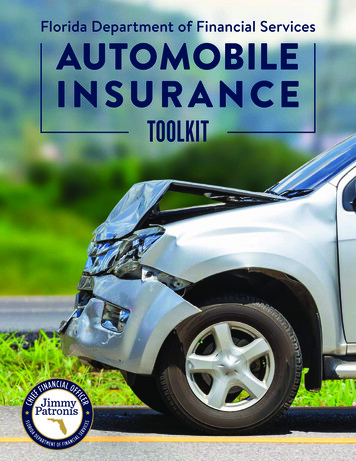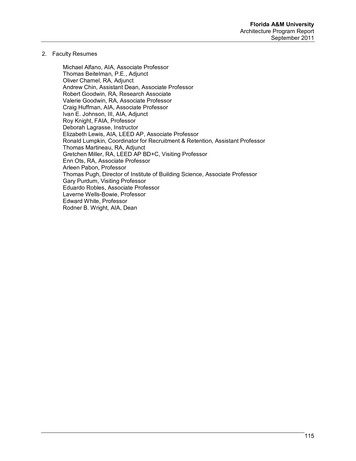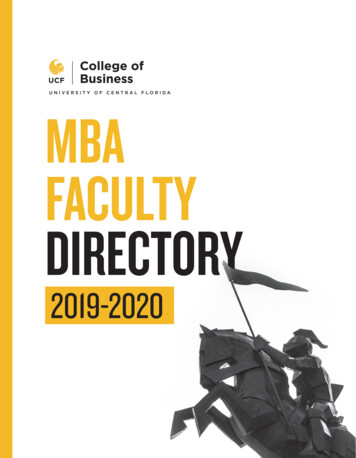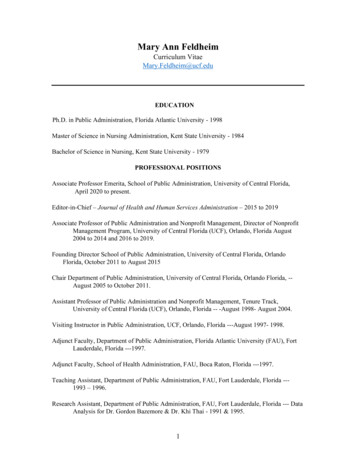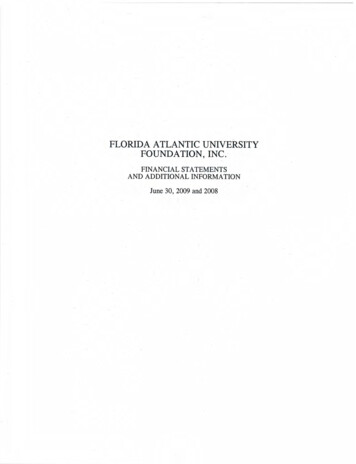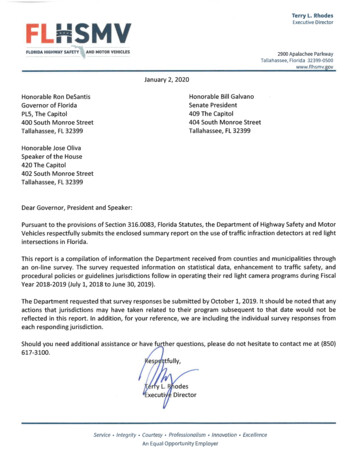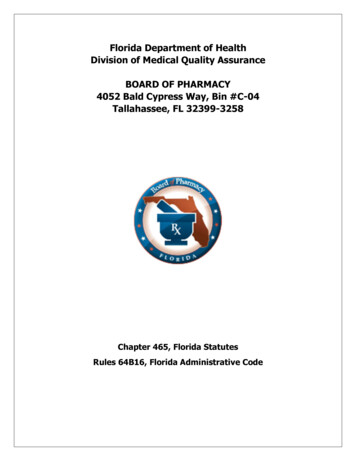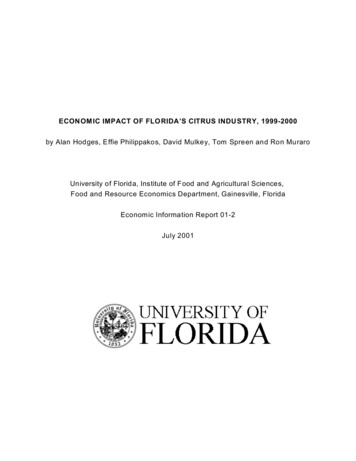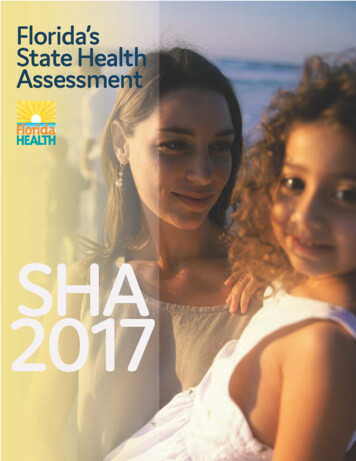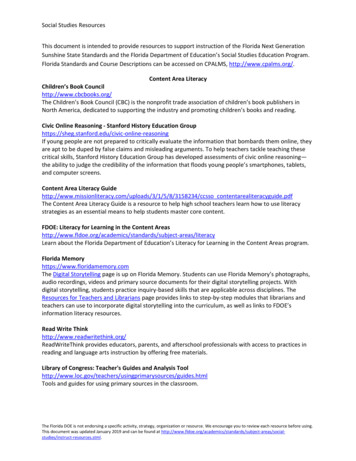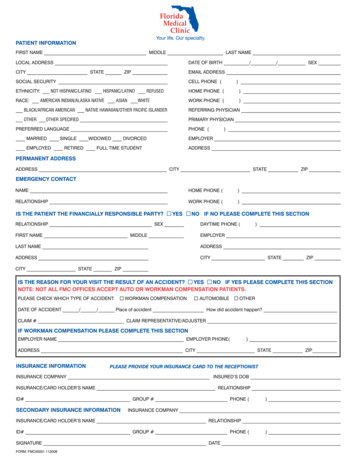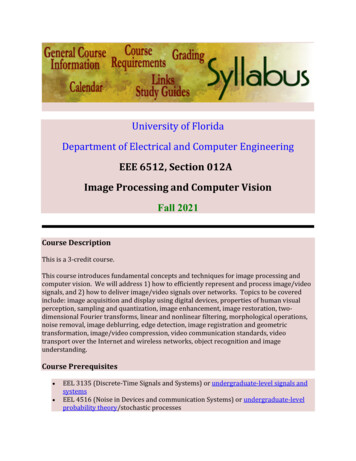
Transcription
University of FloridaDepartment of Electrical and Computer EngineeringEEE 6512, Section 012AImage Processing and Computer VisionFall 2021Course DescriptionThis is a 3-credit course.This course introduces fundamental concepts and techniques for image processing andcomputer vision. We will address 1) how to efficiently represent and process image/videosignals, and 2) how to deliver image/video signals over networks. Topics to be coveredinclude: image acquisition and display using digital devices, properties of human visualperception, sampling and quantization, image enhancement, image restoration, twodimensional Fourier transforms, linear and nonlinear filtering, morphological operations,noise removal, image deblurring, edge detection, image registration and geometrictransformation, image/video compression, video communication standards, videotransport over the Internet and wireless networks, object recognition and imageunderstanding.Course Prerequisites EEL 3135 (Discrete-Time Signals and Systems) or undergraduate-level signals andsystemsEEL 4516 (Noise in Devices and communication Systems) or undergraduate-levelprobability theory/stochastic processes
Some exposure to MATLAB or Python programming languageKnowledge of basic matrix theory (linear algebra) would be helpful, but notnecessaryRequired Textbook Rafael C. Gonzalez, Richard E. Woods, Digital Image Processing,'' 3rd Edition, Prentice Hall; ISBN: 013168728X; August2007. Rafael C. Gonzalez, Richard E. Woods, Digital Image Processing,'' 4th Edition, Pearson; ISBN-13: 9780133356724; 2018.orRecommended Readings George Siogkas, "Visual Media Processing Using Matlab Beginner's Guide," PacktPublishing, 2013. ISBN-10: 1849697205 ISBN-13: 978-1849697200Oge Marques, “Practical Image and Video Processing Using MATLAB,” Wiley, NewYork, NY, 2011. ISBN-10: 0470048158 ISBN-13: 978-0470048153Rafael C. Gonzalez, Richard E. Woods, and S. L. Eddins, Digital Image ProcessingUsing MATLAB,'' Prentice Hall, 2004. ISBN 0130085197.Anil K. Jain, Fundamentals of digital image processing,'' Englewood Cliffs, NJ :Prentice Hall, 1989.Y. Wang, J. Ostermann, and Y.Q.Zhang, "Video Processing and Communications," 1sted., Prentice Hall, 2002. ISBN: 0130175471.D. Taubman and M. Marcellin, "JPEG2000: Image Compression Fundamentals,Standards, and Practice," Kluwer, 2001. ISBN: 079237519X.David A. Forsyth, Jean Ponce, "Computer Vision: A Modern Approach," Prentice Hall;1st edition (August 14, 2002), ISBN: 0130851981.Richard Hartley, Andrew Zisserman, "Multiple View Geometry in Computer Vision,"Paperback: 672 pages; Publisher: Cambridge University Press; 2 edition (March 25,2004) ISBN: 0521540518Yi Ma, Stefano Soatto, Jana Kosecka, S. Shankar Sastry, "An Invitation to 3-D Vision,"Hardcover: 526 pages ; Publisher: Springer-Verlag; (November 14, 2003) ISBN:0387008934A. Ardeshir Goshtasby, "2-D and 3-D Image Registration," Wiley Press, April. 2005.[ebook on NetLibrary]John W. Woods, "Multidimensional Signal, Image, and Video Processing and Coding,"Academic Press; (March 13, 2006), ISBN-10: 0120885166, ISBN-13: 9780120885169.Linda G. Shapiro and George C. Stockman, "Computer Vision," Prentice-Hall, Inc.,Upper Saddle River, New Jersey, 2001 (ISBN 0-13-030796-3).
Emanuele Trucco and Alessandro Verri, "Introductory Techniques for 3-D ComputerVision," Prentice-Hall, Inc., Upper Saddle River, New Jersey, 1998 (ISBN 0-13261108-2).Iain E G Richardson, "H.264 and MPEG-4 Video Compression," John Wiley & Sons,September 2003, ISBN 0-470-84837-5M. E. Al-Mualla, C. N. Canagarajah and D. R. Bull, “Video Coding for MobileCommunications: Efficiency, Complexity and Resilience”, Elsevier Science, AcademicPress, 2002. ISBN: 0120530791A. Gersho, and R. Gray. Vector Quantization and Signal Compression. Boston: KluwerAcademic Publishers, 1992.Instructor:Dr. Dapeng WuOffice: NEB 431Email: dpwu@ufl.eduTA:1) Heng QiaoEmail: hengqiao@ufl.edu2) Haotian JiangEmail: haotian.jiang@ufl.edu3) Tianqi LiuEmail: tianqi.liu1@ufl.edu4) Nidish VashisthaEmail: nidish@ufl.eduCourse 21Meeting TimeMonday, Wednesday, Friday, period 8 (3 pm - 3:50 pm)Meeting RoomNEB 100
Office Hours Dr. Wu: Monday, Wednesday, period 7 (1:55 pm - 2:45 pm), and by appointment viaemail.Structure of the CourseThe course consists of lectures, 6 homework assignments, a quiz, and 1 project.This course is primarily a lecture course. I cover all important material in lectures. SinceEEL 3135 and EEL 4516 are prerequisites, I assume some previous knowledge about DSP,probability theory and stochastic processes, and hence I will cover some material veryquickly. Thus, depending on what and how much you recall from earlier study, varyingamounts of reading in introductory books on DSP, probability theory and stochasticprocesses (other than the course textbook) may be necessary; these readings are up to thestudent. I will only give reading assignments from the course textbook.Attending lecture is quite important as I may cover material not available in any bookeasily accessible to you. I use Powerpoint presentation during lecture. Lecture notes willbe posted on the course website before the class. The lecture is to engage the students inindependent thinking, critical thinking, and creative thinking, help the students organizethe knowledge around essential concepts and fundamental principles, and developconditionalized knowledge which tells them when, where and why a certain method isapplicable to solving the problem they encounter.I do not intend for the WWW material to be a substitute for attending lecture sinceengaging the students in active thinking, making logical connections between the oldknowledge and the new knowledge, and providing insights are the objectives of mylecture. The lecture notes are posted on the web so that you can miss an occasional lectureand still catch up, and it makes taking notes easier.Course Outline Overview of image processing systems, Image formation and perception,Continuous and digital image representationImage quantization: uniform and nonuniform, visual quantization (dithering).Image contrast enhancement: linear and non-linear stretching, histogramequalization.Continuous and discrete-time Fourier Transforms in 2D; and linear convolution in2D.Image smoothing and image sharpening by spatial domain linear filtering; Edgedetection.Discrete Fourier transform in 1D and 2D, and image filtering in the DFT domain.Median filtering and Morphological filtering.Color representation and display; true and pseudo color image processing.
Image sampling and sampling rate conversion (resize).Lossless image compression: The concept of entropy and Huffman coding;Runlength coding for bi-level images; CCITT facsimile compression standards.Lossy image compression: Image quantization revisited; Predictive coding;Transform coding; JPEG image compression standard.Imaging Geometry; Coordinate transformation and geometric warping for imageregistration.Object recognitionCourse ObjectivesUpon the completion of the course, the student should be able to know the fundamental techniques for image processing, video processing, andcomputer visionunderstand the basics of analog and digital video: video representation andtransmissionacquire the basic skill of designing image/video compressionfamiliarize himself/herself with image/video compression standardsHandoutsPlease find handouts here.Course Policies Attendance:o Perfect class attendance is not required, but regular attendance is expected.o It is the student's responsibility to independently obtain any missed material(including handouts) from lecture.During lecture, cell phones should be turned off.No late submissions of your homework solution, and projectproposal/report, are allowed unless U.F. approved reasons are supplied andadvance permission is granted by the instructor. Excused late submissionsmust be consistent with university policies in the Graduate ns) and require appropriate
documentation. Additional information can be foundhere: are useo All faculty, staff and student of the University are required and expected to obeythe laws and legal agreements governing software use. Failure to do so can leadto monetary damages and/or criminal penalties for the individualviolator. Because such violations are also against University policies and rules,disciplinary action will be taken as appropriate. We, the members of theUniversity of Florida community, pledge to uphold ourselves and our peers to thehighest standards of honesty and integrity.Announcements:o All students are responsible for announcements made in lecture, on thestudent access website, or via the class email list.o It is expected that you will check your email several times per week forpossible course announcements.Students Requiring Accommodationso Students with disabilities who experience learning barriers and would like torequest academic accommodations should connect with the disability ResourceCenter by visiting https://disability.ufl.edu/students/get-started/. It is importantfor students to share their accommodation letter with their instructor and discusstheir access needs, as early as possible in the semester.University Honesty PolicyUF students are bound by The Honor Pledge which states, “We, the members of theUniversity of Florida community, pledge to hold ourselves and our peers to the higheststandards of honor and integrity by abiding by the Honor Code. On all work submitted forcredit by students at the University of Florida, the following pledge is either required orimplied: “On my honor, I have neither given nor received unauthorized aid in doing thisassignment.” The Honor Code ucthonor-code/) specifies a number of behaviors that are in violation of this code and thepossible sanctions. Furthermore, you are obligated to report any condition that facilitatesacademic misconduct to appropriate personnel. If you have any questions or concerns,please consult with the instructor or TAs in this class.Students are encouraged to discuss class material in order to better understand concepts.All homework answers must be the author's own work. However, students are encouragedto discuss homework to promote better understanding. What this means in practice is thatstudents are welcome to discuss problems and solution approaches, and in fact cancommunally work solutions at a board. However, the material handed in must be preparedstarting with a clean sheet of paper (and the author's recollection of any solution session),but not refer to any written notes or existing code from other students during the writing ofthe solution. In other words, writing the homework report shall be an exercise indemonstrating the student understands the materials on his/her own, whether or not helpwas provided in attaining that understanding.All work submitted in this course must be your own and produced exclusively for thiscourse. The use of sources (ideas, quotations, paraphrases) must be properly
acknowledged and documented. For the copy of the UF Honor Code and ://www.dso.ufl.edu/sccr/honorcodes/honorcode.php. Violations will be takenseriously and are noted on student disciplinary records. If you are in doubt regardingthe requirements, please consult with the instructor before you complete anyrequirement of the course.Course EvaluationStudents are expected to provide professional and respectful feedback on the quality ofinstruction in this course by completing course evaluations online via GatorEvals. Guidanceon how to give feedback in a professional and respectful manner is availableat https://gatorevals.aa.ufl.edu/students/. Students will be notified when the evaluationperiod opens, and can complete evaluations through the email they receive from GatorEvals,in their Canvas course menu under GatorEvals, or via ationresultsareavailabletostudentsat lass RecordingStudents are allowed to record video or audio of class lectures. However, the purposes forwhich these recordings may be used are strictly controlled. The only allowable purposesare (1) for personal educational use, (2) in connection with a complaint to the university, or(3) as evidence in, or in preparation for, a criminal or civil proceeding. All other purposesare prohibited. Specifically, students may not publish recorded lectures without the writtenconsent of the instructor.A “class lecture” is an educational presentation intended to inform or teach enrolled students abouta particular subject, including any instructor-led discussions that form part of the presentation, anddelivered by any instructor hired or appointed by the University, or by a guest instructor, as part ofa University of Florida course. A class lecture does not include lab sessions, student presentations,clinical presentations such as patient history, academic exercises involving solely studentparticipation, assessments (quizzes, tests, exams), field trips, private conversations betweenstudents in the class or between a student and the faculty or lecturer during a class session.Publication without permission of the instructor is prohibited. To “publish” means to share,transmit, circulate, distribute, or provide access to a recording, regardless of format or medium, toanother person (or persons), including but not limited to another student within the same classsection. Additionally, a recording, or transcript of a recording, is considered published if it is postedon or uploaded to, in whole or in part, any media platform, including but not limited to social media,book, magazine, newspaper, leaflet, or third party note/tutoring services. A student who publishesa recording without written consent may be subject to a civil cause of action instituted by a personinjured by the publication and/or discipline under UF Regulation 4.040 Student Honor Code andStudent Conduct Code.Commitment to a Safe and Inclusive Learning EnvironmentThe Herbert Wertheim College of Engineering values broad diversity within ourcommunity and is committed to individual and group empowerment, inclusion, and the
elimination of discrimination. It is expected that every person in this class will treat oneanother with dignity and respect regardless of gender, sexuality, disability, age,socioeconomic status, ethnicity, race, and culture.If you feel like your performance in class is being impacted by discrimination orharassment of any kind, please contact your instructor or any of the following: Your academic advisor or Graduate Program Coordinator Jennifer Nappo, Director of Human Resources, 352-392-0904, jpennacc@ufl.edu Curtis Taylor, Associate Dean of Student Affairs, 352-392-2177, taylor@eng.ufl.edu Toshikazu Nishida, Associate Dean of Academic Affairs, 352-3920943, nishida@eng.ufl.eduSoftware UseAll faculty, staff, and students of the University are required and expected to obey the lawsand legal agreements governing software use. Failure to do so can lead to monetarydamages and/or criminal penalties for the individual violator. Because such violations arealso against University policies and rules, disciplinary action will be taken as appropriate.We, the members of the University of Florida community, pledge to uphold ourselves andour peers to the highest standards of honesty and integrity.Student PrivacyThere are federal laws protecting your privacy with regards to grades earned in coursesand on individual assignments. For more information, please regulationferpa.htmlCampus Resources:Health and WellnessCovid-19 Protocols: You are expected to wear approved face coverings at all times during class and withinbuildings even if you are vaccinated. Please continue to follow healthy habits, including bestpractices like frequent hand washing. Following these practices is our responsibility as Gators. If you are sick, stay home and self-quarantine. Please visit the UF Health Screen, Test &Protect website about next steps, retake the questionnaire and schedule your test for no soonerthan 24 hours after your symptoms began. Please call your primary care provider if you are ill andneed immediate care or the UF Student Health Care Center at 352-392-1161 (oremail covid@shcc.ufl.edu) to be evaluated for testing and to receive further instructions about
returning to campus. UF Health Screen, Test & Protect offers guidance when you are sick, have beenexposed to someone who has tested positive or have tested positive yourself. Visit the UF HealthScreen, Test & Protect website for more information.U Matter, We Care:Your well-being is important to the University of Florida. The U Matter, We Care initiative iscommitted to creating a culture of care on our campus by encouraging members of our communityto look out for one another and to reach out for help if a member of our community is in need. If youor a friend is in distress, please contact umatter@ufl.edu so that the U Matter, We Care Team canreach out to the student in distress. A nighttime and weekend crisis counselor is available by phoneat 352-392-1575. The U Matter, We Care Team can help connect students to the many other helpingresources available including, but not limited to, Victim Advocates, Housing staff, and the Counselingand Wellness Center. Please remember that asking for help is a sign of strength. In case ofemergency, call 9-1-1.Counseling and Wellness Center: https://counseling.ufl.edu, and 392-1575; and the UniversityPolice Department: 392-1111 or 9-1-1 for emergencies.Sexual Discrimination, Harassment, Assault, or ViolenceIf you or a friend has been subjected to sexual discrimination, sexual harassment, sexual assault, orviolence contact the Office of Title IX Compliance, located at Yon Hall Room 427, 1908 StadiumRoad, (352) 273-1094, title-ix@ufl.eduSexual Assault Recovery Services (SARS)Student Health Care Center, 392-1161.University Police Department at 392-1111 (or 9-1-1 for emergencies),or http://www.police.ufl.edu/.Academic ResourcesE-learning technical support, 352-392-4357 (select option 2) or e-mail to Learningsupport@ufl.edu. https://lss.at.ufl.edu/help.shtml.Career Resource Center, Reitz Union, 392-1601. Career assistance andcounseling. https://www.crc.ufl.edu/.Library Support, http://cms.uflib.ufl.edu/ask. Various ways to receive assistance withrespect to using the libraries or finding resources.Teaching Center, Broward Hall, 392-2010 or 392-6420. General study skills andtutoring. https://teachingcenter.ufl.edu/.
Writing Studio, 302 Tigert Hall, 846-1138. Help brainstorming, formatting, and writingpapers. https://writing.ufl.edu/writing-studio/.Student Complaints Campus: https://www.dso.ufl.edu/documents/UF Complaints policy.pdf.On-Line Students Complaints: ess.Grading:GradesPercentageDue DatesHomework30%See the course calendarProject proposal10%4pm, October 29Quiz10%December 8Project report50%4pm, December 15The project report consists of1.2.3.4.(50%) A written report for your project(25%) Computer programs that you develop for your project(10%) Powerpoint file of your presentation(15%) Your presentation/demo video on YouTubeGrading scale:Top 25% students will receive A. Average score will be at least B .More information on UF grading policy may be found ns/info/grades.aspxHomework: Due dates of assignments are specified in the course calendar.No late submissions are allowed unless U.F. approved reasons are supplied and advancepermission is granted by the instructor. Excused late submissions must be consistent withuniversity policies in the Graduate Catalog (https://catalog.ufl.edu/graduate/regulations)
and require appropriate documentation. Additional information can be foundhere: https://catalog.ufl.edu/graduate/regulations/If you wish to dispute a homework grade, you must return the assignment along with asuccinct written argument within one week after the graded materials have been returnedto the class. Simple arithmetic errors in adding up grade totals are an exception, and cannormally be handled verbally on-the-spot during office hours of the TA. For all otherdisputes, the entire homework may be (non-maliciously) re-graded, which may result inincrease or decrease of points.Class Project:The class project will be done individually (that is, teaming with other students is notallowed). Each project requires a proposal and a final report. The final report is expectedto be in the format of a conference paper plus computer programs, a Powerpoint file, and avideo. On Oct. 29, the project proposal (up to 2 pages) is due. On Dec. 15, the final report (upto 10 pages) is due. For details about the project, please read here.Suggested topics for projects are listed here.Course calendar can be found here.Related courses in other schools:George Mason University, Computer VisionJohns Hopkins University, Image Compression and Packet VideoPolytechnic University, Video ProcessingPurdue University, Digital Video Systems
Stanford University, Digital Video ProcessingUniversity of California, Berkeley, Multimedia Signal Processing, Communications andNetworkingUniversity of Maryland, College Park, Digital Image ProcessingUniversity of Maryland, College Park, Multimedia Communication & Information Security: ASignal Processing PerspectiveUseful links Anaconda: Anaconda is the leading open data science platform powered by Python.Theano: Theano is a Python library that lets you to define, optimize, and evaluatemathematical expressions, especially ones with multi-dimensional arrays(numpy.ndarray).TensorFlow: TensorFlow is an open source software library for numericalcomputation using data flow graphs. Nodes in the graph represent mathematicaloperations, while the graph edges represent the multidimensional data arrays(tensors) communicated between them. The flexible architecture allows you todeploy computation to one or more CPUs or GPUs in a desktop, server, or mobiledevice with a single API.Keras: Keras is a minimalist, highly modular neural networks library, written inPython and capable of running on top of either TensorFlow or Theano. It wasdeveloped with a focus on enabling fast experimentation. Being able to go from ideato result with the least possible delay is key to doing good research.PyTorch: PyTorch is a deep learning framework for fast, flexible experimentation.A curated list of resources dedicated to recurrent neural networksSource code in Python for handwritten digit recognition, using deep neuralnetworks: [another link]Source code in PyTorch for handwritten digit recognition, using deep neuralnetworksSource code in Python for TF-mRNN: a TensorFlow library for image captioningSource code in Python for the following work on image captioning:o Oriol Vinyals, Alexander Toshev, Samy Bengio, Dumitru Erhan, Show andTell: A Neural Image Caption Generator, CVPR 2015§ ImplementationImage captioning:o Zhe Gan, et. al, Semantic Compositional Networks for Visual Captioning, CVPR2017§ Implementation Source code in Python (Theano)o Bottom-Up and Top-Down Attention for Image Captioning and VisualQuestion Answering: source codes (Caffe) and source codes (PyTorch)Microsoft COCO datasets
Visual Question Answering:o Bottom-Up and Top-Down Attention for Image Captioning and VisualQuestion Answering: source codes (Caffe) and VQA source code(PyTorch)Semantic Propositional Image Caption Evaluation (SPICE)o Source code in JAVA to calculate SPICERegion-based Convolutional Neural Networks (R-CNN)o References:§ Ren, Shaoqing, Kaiming He, Ross Girshick, and Jian Sun. "Faster RCNN: Towards real-time object detection with region proposalnetworks." In Advances in neural information processing systems, pp.91-99. 2015. [pdf]§ Dai, Jifeng, Yi Li, Kaiming He, and Jian Sun. "R-FCN: Object detectionvia region-based fully convolutional networks." In Advances in neuralinformation processing systems, pp. 379-387. 2016. [pdf] [sourcecode]§ Huang, Jonathan, Vivek Rathod, Chen Sun, Menglong Zhu, AnoopKorattikara, Alireza Fathi, Ian Fischer et al. "Speed/accuracy tradeoffs for modern convolutional object detectors." arXiv preprintarXiv:1611.10012 (2016). [pdf] (E.g., for Inception V3, extractfeatures from the “Mixed 6e” layer whose stride size is 16 pixels.Feature maps are cropped and resized to 17x17.)o Source codes:§ A Faster Pytorch Implementation of Faster R-CNN (PyTorch)§ Bottom-Up and Top-Down Attention for Image Captioning and VisualQuestion Answering: source codes (Caffe)Source code in Python for end-to-end training of LSTMo ImplementationBidirectional Encoder Representations from Transformers (BERT)o Implementation in TensorFlowo Implementation in PyTorchSource code in Python for sequence-to-sequence learning (language translation,chatbot)o TensorFlow seq2seq libraryo Implementation 1 on Tensorflow with separable encoder and decodero Implementation 2 on KerasVisual Storytelling Dataset (VIST)o Visual storytelling algorithms:§ No Metrics Are Perfect: Adversarial REward Learning for VisualStorytelling: source codes (TensorFlow)Visual Genome is a dataset, a knowledge base, an ongoing effort to connectstructured image concepts to language.MPII Movie & Description dataset for automatic video description, video summary,video storytellingBidirectional recurrent neural networks (B-RNN):
Graves, Alan, Navdeep Jaitly, and Abdel-rahman Mohamed. "Hybrid speechrecognition with deep bidirectional LSTM." IEEE Workshop on AutomaticSpeech Recognition and Understanding (ASRU), 2013. [pdf]Deep reinforcement learningo UCL Course on reinforcement learning: [ppt] [video]o References:§ Mnih, Volodymyr, Koray Kavukcuoglu, David Silver, Alex Graves,Ioannis Antonoglou, Daan Wierstra, and Martin Riedmiller. "Playingatari with deep reinforcement learning." arXiv preprintarXiv:1312.5602 (2013).§ Mnih, Volodymyr, Koray Kavukcuoglu, David Silver, Andrei A. Rusu,Joel Veness, Marc G. Bellemare, Alex Graves et al. "Human-levelcontrol through deep reinforcement learning." Nature 518, no. 7540(2015): 529-533. [source code]§ How to Study Reinforcement Learningo Source codes:§ Implementation of Reinforcement Learning Algorithms. Python,OpenAI Gym, Tensorflow. Exercises and Solutions to accompanySutton's Book and David Silver's course. [link]Generative Adversarial Network (GAN)o References:§ Goodfellow, Ian, Jean Pouget-Abadie, Mehdi Mirza, Bing Xu, DavidWarde-Farley, Sherjil Ozair, Aaron Courville, and Yoshua Bengio."Generative adversarial nets." In Advances in neural informationprocessing systems, pp. 2672-2680. 2014.§ Radford, Alec, Luke Metz, and Soumith Chintala. "Unsupervisedrepresentation learning with deep convolutional generativeadversarial networks." arXiv preprint arXiv:1511.06434 (2015).§ Arjovsky, Martin, Soumith Chintala, and Léon Bottou. "WassersteinGAN." arXiv preprint arXiv:1701.07875 (2017).o Types of GAN1. Vanilla GAN2. Conditional GAN3. InfoGAN4. Wasserstein GAN5. Mode Regularized GAN6. Coupled GAN7. Auxiliary Classifier GAN8. Least Squares GAN9. Boundary Seeking GAN10. Energy Based GAN11. f-GAN12. Generative Adversarial Parallelization13. DiscoGAN14. Adversarial Feature Learning & Adversarially Learned Inference15. Boundary Equilibrium GANo
16. Improved Training for Wasserstein GAN17. DualGAN18. MAGAN: Margin Adaptation for GAN19. Softmax GANo Source codes:§ A Tensorflow Implementation of "Deep Convolutional GenerativeAdversarial Networks": python code§ Collection of generative models, e.g. GAN, VAE in Pytorch andTensorflow: python codeSequential Generative Adversarial Network (GAN)o References:§ Yu, Lantao, Weinan Zhang, Jun Wang, and Yong Yu. "SeqGAN:Sequence Generative Adversarial Nets with Policy Gradient." In AAAI,pp. 2852-2858. 2017.§ Mogren, Olof. "C-RNN-GAN: Continuous recurrent neural networkswith adversarial training." arXiv preprint arXiv:1611.09904 (2016).§ Im, Daniel Jiwoong, Chris Dongjoo Kim, Hui Jiang, and RolandMemisevic. "Generating images with recurrent adversarialnetworks." arXiv preprint arXiv:1602.05110 (2016).§ Press, Ofir, Amir Bar, Ben Bogin, Jonathan Berant, and Lior Wolf."Language Generation with Recurrent Generative AdversarialNetworks without Pre-training." arXiv preprintarXiv:1706.01399 (2017).o Source codes:§ Implementation of C-RNN-GAN§ Tensorflow Implementation of GAN modeling for sequential dataSubjective evaluation for content aware video processing techniquesMATLAB TutorialMATLAB CentralMatlab Primer, Matlab Manuals, Image Processing ToolboxMatlab implementation of image/video compression algorithmsIntroduction to Matarix Algebra (free book by Autar K Kaw, Professor,University of South Florida).Matrix Reference ManualHIPR2: a WWW-based Image Processing Teaching Materials with JLIDARLearning by simulationsOpenCVOpenGLDownload the following free (open source) program to record video with screencapture: d CNadwsW66wCFSVjTAodbjzTSgSD and HD video sequences for evaluating coding performance of videocodec: http://media.xiph.org/video/derf/WebRTC: WebRTC is a free, open-source project that enables web browsers withReal-Time Communications (RTC) capabilities via simple JavaScript APIs.
The Missing Semester of Your CS EducationStandards: H.264 tutorialH.263MPEG4 overview can be foundat mpeg-4.htmJPEG XRKTA (contender for future H.265)ATSC (Advanced Television Systems Committee) & HDTV (High DefinitionTelevision):ATSC.orgHDTVSMPTE.orgMPEG (Moving Picture Experts Group):MPEG.orgMPEG standards committeeMPEG TVM
Students are allowed to record video or audio of class lectures. However, the purposes for which these recordings may be used are strictly controlled. The only allowable purposes are (1) for personal educational use, (2) in connection with a complaint to the university, or (3) as evidence in, or in preparation for, a criminal or civil proceeding.

